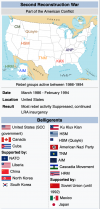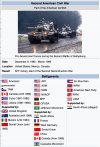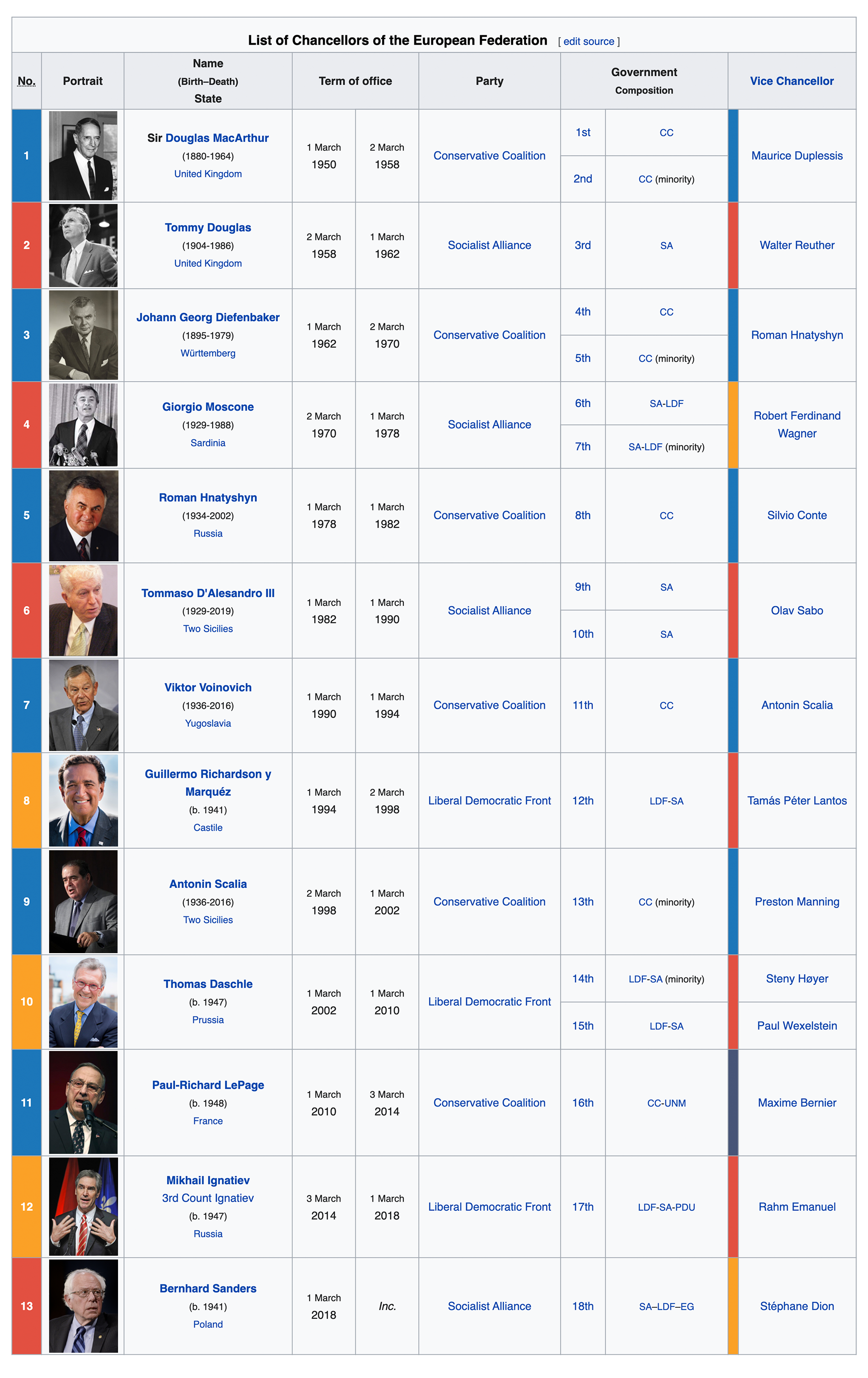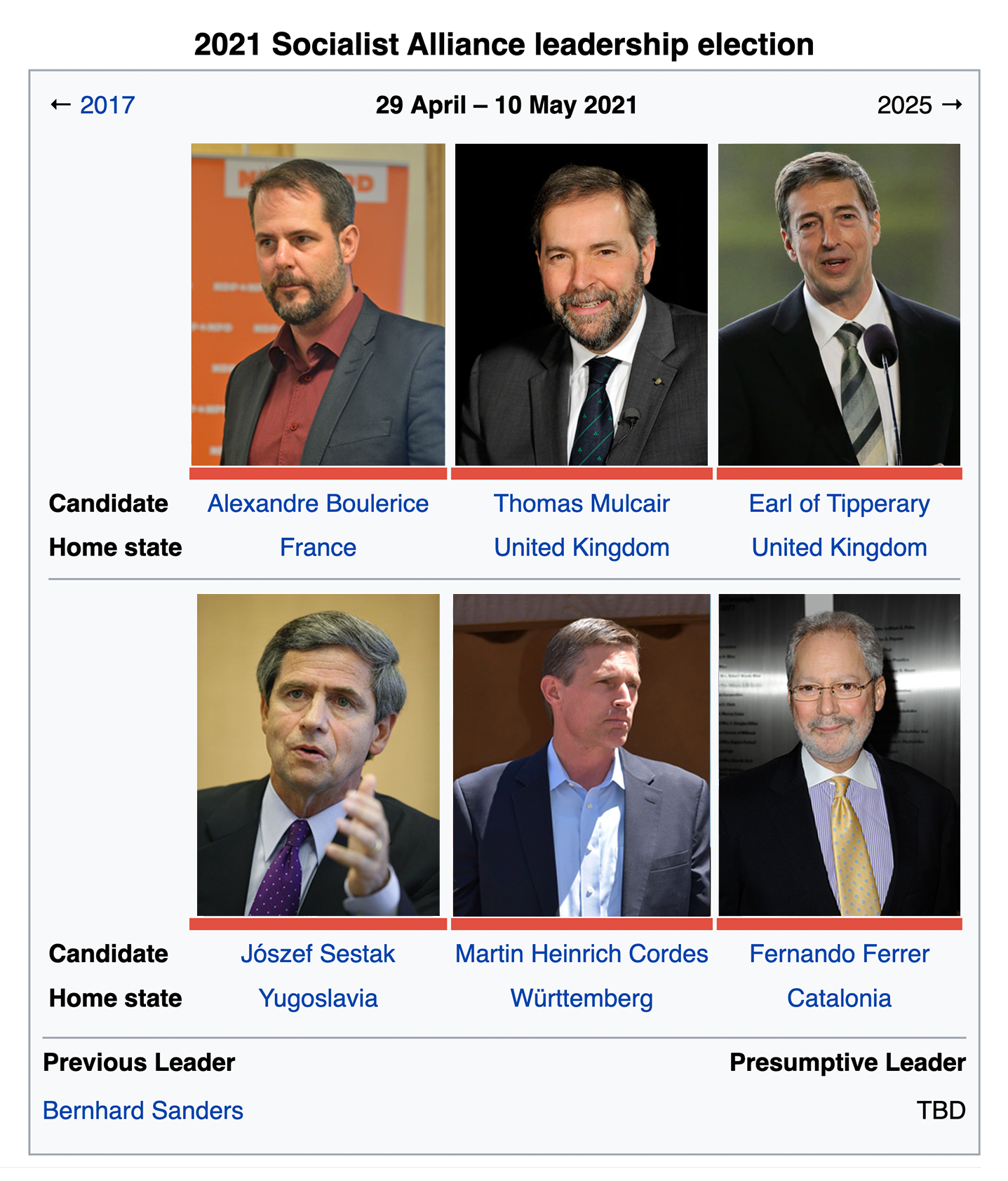More wikiboxe from my Decembrist Victory TL
Same wolrd as these:
Europe in 1840
First Russian Republic
Alexander, prince-consort of the UK
Second French Republic
August V of Poland, Konstantin Fredrik I of Finland, Friedrich Eugen of Livonia
Mexican-American War (1829-1831) and USA Presidental elections of 1832
The Jewish Republic
List of presidents of the Jewish Republic
and now - one of the most important events of TTL XIX century

Liberation War, also called Italian War of 1843 (though the main battles was fight outside Italy) or the Great War – until the really Great World War started – was the successful attempt of Russian Dictator Mikhail Orlov and French Emperor Napoleon III to broke out the Holy Alliance Europe. It was the greatest conflict in Europe since the times of Napoleonic Wars and stayed these until the World War.
War started August 1843, when the so-called Milan Revolution started in the Austrian lands in Northern Italy. Lombardian rebels were supported by other Italians, which led to Carl Albert of Sardinia declaration of war against Austrian Empire in August 16, followed by other Italian states, include even Habsburgs of Tuscany. It seems, that Italy would crush the I talian armies easy, but Emperor of the French Napoleon III took part in the party, and French army invade Lombardy.
But in was not all. After Milan fall to the French and Sardinians in February 1844, Poland-Lithuania, officially member of the Holy Alliance, and secret ally of France and Russia, invade Austrian Galicia. Prussia goes to a help to Austria and Prussian army invade Poland. Then, Russian State Army (according to a pre-agreed with France and Poland plan of the campaign) goes to Poland to fight Austrians and Prussians. Russo-Polish army, lead by Alexey Orlov (brother of the Russian Dictator Mikhail Orlov) and Józef Chłopicki, could stop Prussians in the epic Battle of Plock (which Russian and Polish Propaganda compared with Tannenberg Battle of XV century). From that time, it was not only war in Italy, but a Global Conflict. UK soon support Prussia and Austria in the war, and even Ottoman Empire declares war to Russia, in attempt to took a revanche for the previous defeats.
It was the last Revolutionary War in Europe and the first war of the new Industrial Era. There was not only millions of soldiers, fight each other over the Europe, but new Rifles, new Cannons, mitrailleuses [invented TTL early than OTL]. Also in was Railways, sea mines, first invented in Prussia and the French fleet new sea super-weapon – the ironclads [10 years early than OTL], that horrors British. All it leads to the enormous number of death and wounded – arts of war did not keep pace with the development of technology, and officers often did not now what to do to keep the lives of their soldiers.
Finally, war ends with the Holy Alliance defeat. Therritorian changes was not so great, mostly because Napoleon III did not support the Orlov’s Idea to dismember the Austria and create independent Ungary and Czehia. Austria lose Lombardo-Venetia to Sardinia (which give Nice and Savoy to France as pay for the support in the war), Bessarabia da the Danube Estuary to Russia, Galicia to Poland (western part – in Lviv, Ruthenian [OTL Western Ukrainian, TTL they would developed into a separate nation] nationalists from the Golovna Ruthenian Rada had time to took power and declare an independent Republic of Ruthenia. Russia officially supported Ruthenia, and after a long negotiations, Poland agree to waive claims to Lviv in exchange to a Prussuan port of Memel in the Baltic). Danbbian principarties, which was under Austrian protection since 1829, was divided – Moldova was annexed by Russia, and Wallachia became a member state In the Danubian Union – new constitutional and federative version of the Habsburgs empire. Prussia lose Duchy of Poznan and Memel to Poland and Neuchâtel in Switzerland to France. Ottoman Empire lose Kars region where the new independent Armenia was proclaimed, Christian Mount Lebanon, which gain independence under the French Protectorate, and was forced to secede all Syria to Ibrahim, son of the Mohammed Ali of Egypt, which can came to a play in time.
An Era was ended in Europe – Era of Revolutions and Reaction. New Era starts.
Same wolrd as these:
Europe in 1840
First Russian Republic
Alexander, prince-consort of the UK
Second French Republic
August V of Poland, Konstantin Fredrik I of Finland, Friedrich Eugen of Livonia
Mexican-American War (1829-1831) and USA Presidental elections of 1832
The Jewish Republic
List of presidents of the Jewish Republic
and now - one of the most important events of TTL XIX century
Liberation War, also called Italian War of 1843 (though the main battles was fight outside Italy) or the Great War – until the really Great World War started – was the successful attempt of Russian Dictator Mikhail Orlov and French Emperor Napoleon III to broke out the Holy Alliance Europe. It was the greatest conflict in Europe since the times of Napoleonic Wars and stayed these until the World War.
War started August 1843, when the so-called Milan Revolution started in the Austrian lands in Northern Italy. Lombardian rebels were supported by other Italians, which led to Carl Albert of Sardinia declaration of war against Austrian Empire in August 16, followed by other Italian states, include even Habsburgs of Tuscany. It seems, that Italy would crush the I talian armies easy, but Emperor of the French Napoleon III took part in the party, and French army invade Lombardy.
But in was not all. After Milan fall to the French and Sardinians in February 1844, Poland-Lithuania, officially member of the Holy Alliance, and secret ally of France and Russia, invade Austrian Galicia. Prussia goes to a help to Austria and Prussian army invade Poland. Then, Russian State Army (according to a pre-agreed with France and Poland plan of the campaign) goes to Poland to fight Austrians and Prussians. Russo-Polish army, lead by Alexey Orlov (brother of the Russian Dictator Mikhail Orlov) and Józef Chłopicki, could stop Prussians in the epic Battle of Plock (which Russian and Polish Propaganda compared with Tannenberg Battle of XV century). From that time, it was not only war in Italy, but a Global Conflict. UK soon support Prussia and Austria in the war, and even Ottoman Empire declares war to Russia, in attempt to took a revanche for the previous defeats.
It was the last Revolutionary War in Europe and the first war of the new Industrial Era. There was not only millions of soldiers, fight each other over the Europe, but new Rifles, new Cannons, mitrailleuses [invented TTL early than OTL]. Also in was Railways, sea mines, first invented in Prussia and the French fleet new sea super-weapon – the ironclads [10 years early than OTL], that horrors British. All it leads to the enormous number of death and wounded – arts of war did not keep pace with the development of technology, and officers often did not now what to do to keep the lives of their soldiers.
Finally, war ends with the Holy Alliance defeat. Therritorian changes was not so great, mostly because Napoleon III did not support the Orlov’s Idea to dismember the Austria and create independent Ungary and Czehia. Austria lose Lombardo-Venetia to Sardinia (which give Nice and Savoy to France as pay for the support in the war), Bessarabia da the Danube Estuary to Russia, Galicia to Poland (western part – in Lviv, Ruthenian [OTL Western Ukrainian, TTL they would developed into a separate nation] nationalists from the Golovna Ruthenian Rada had time to took power and declare an independent Republic of Ruthenia. Russia officially supported Ruthenia, and after a long negotiations, Poland agree to waive claims to Lviv in exchange to a Prussuan port of Memel in the Baltic). Danbbian principarties, which was under Austrian protection since 1829, was divided – Moldova was annexed by Russia, and Wallachia became a member state In the Danubian Union – new constitutional and federative version of the Habsburgs empire. Prussia lose Duchy of Poznan and Memel to Poland and Neuchâtel in Switzerland to France. Ottoman Empire lose Kars region where the new independent Armenia was proclaimed, Christian Mount Lebanon, which gain independence under the French Protectorate, and was forced to secede all Syria to Ibrahim, son of the Mohammed Ali of Egypt, which can came to a play in time.
An Era was ended in Europe – Era of Revolutions and Reaction. New Era starts.
Last edited:







